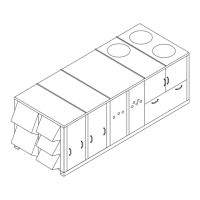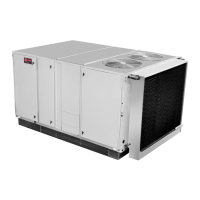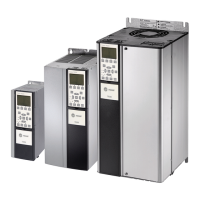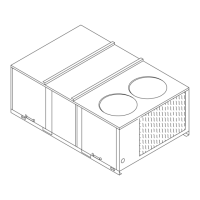74
RT-SVX34R-EN
Table 46. Test mode states for SZ VAV units with modulating hot gas reheat and modulating heat
TEST
STEP MODE FAN
VFD
COMMAND ECON
COMP
1
COMP
2
COMP
3
HEAT
OUTPUT
PUMP-
OUT
COOL
VALVE
RE-
HEAT
VALVE
1 FAN ON ON
45% (0
VDC)
MIN OFF OFF OFF 0% OFF 100% 0%
2
ECONO-
MIZER
ON
45% (0
VDC)
OPEN OFF OFF OFF 0% OFF 100% 0%
3 COOL 1 ON
80% (6.67
VDC)
MIN ON OFF OFF 0%
IN-
CON-
TROL
100% 0%
4 COOL 2 ON
IN-
CONTROL
MIN ON ON OFF 0%
IN-
CON-
TROL
100% 0%
5 COOL 3 ON
IN-
CONTROL
MIN ON ON ON 0%
IN-
CON-
TROL
100% 0%
6 REHEAT ON
73% (5.24
VDC)
MIN ON ON ON 0%
IN-
CON-
TROL
50% 50%
7 HEAT 1 ON
100% (10
VDC)
MIN OFF OFF OFF 50% OFF 100% 0%
8 HEAT 2 ON
100% (10
VDC)
MIN OFF OFF OFF 100% OFF 100% 0%
9 RESET
Notes:2 & 3 stage standard efficiency units (excluding 40-50T Std Efficiency CV):
1. For Traditional VAV units, the VFD Command when “In-Control” will be controlled based on Supply Air Pressure Requirements. For SZ VAV
units, the VFD Command will be at discrete points during Test Mode.
2. For 27.5-35T units, both compressors will be energized during the Cool 2 Step. For 40-50T units, only Compressor 2 will be energized during
the Cool 2 Step.
3. The Reheat Pumpout relay will be energized any time the Reheat circuit is energized in active Cooling Mode.
4. For units with Statitrac installed, the Exhaust Damper will track the Economizer position during Service Test Mode and the Exhaust Fan will be
energized once the Economizer rises above the Exhaust Enable Setpoint.
Notes:5 stage high efficiency units (including 40-50T Std Efficiency CV):
1. Compressor 1 is the smaller compressor on the circuit.
2. Condenser fans are controlled as defined for normal operation.
3. Exhaust fan operates as defined for normal operation based on economizer position.
4. When Compressor 1 is energized with either C1, C2, or with both for 30 minutes continuously, C3 will be required to de-energize for 30
seconds.
Verifying Proper Fan Rotation
WWAARRNNIINNGG
RRoottaattiinngg CCoommppoonneennttss!!
FFaaiilluurree ttoo ddiissccoonnnneecctt ppoowweerr bbeeffoorree sseerrvviicciinngg ccoouulldd
rreessuulltt iinn rroottaattiinngg ccoommppoonneennttss ccuuttttiinngg aanndd ssllaasshhiinngg
tteecchhnniicciiaann wwhhiicchh ccoouulldd rreessuulltt iinn ddeeaatthh oorr sseerriioouuss
iinnjjuurryy..
DDiissccoonnnneecctt aallll eelleeccttrriicc ppoowweerr,, iinncclluuddiinngg rreemmoottee
ddiissccoonnnneeccttss bbeeffoorree sseerrvviicciinngg.. FFoollllooww pprrooppeerr
lloocckkoouutt//ttaaggoouutt pprroocceedduurreess ttoo eennssuurree tthhee ppoowweerr
ccaann nnoott bbee iinnaaddvveerrtteennttllyy eenneerrggiizzeedd..
Using , p. 68 to Table 46, p. 74 as a reference,
momentarily jump across the test terminals to start the
Minimum Ventilation Test.
The Exhaust Fan will start anytime the economizer
damper position is equal to or greater than the exhaust
fan setpoint.
The economizer will drive to the minimum position
setpoint, exhaust fans may start at random, and the
supply fan will start.
Once the supply fan has started, check for proper
rotation. The direction of rotation is indicated by an
arrow on the fan housing.
If the fan is rotating backwards, open the main power
disconnect switch upstream of the unit terminal block
or the unit factory mounted disconnect switch.
WWAARRNNIINNGG
HHaazzaarrddoouuss VVoollttaaggee!!
FFaaiilluurree ttoo ddiissccoonnnneecctt ppoowweerr bbeeffoorree sseerrvviicciinngg ccoouulldd
rreessuulltt iinn ddeeaatthh oorr sseerriioouuss iinnjjuurryy..
DDiissccoonnnneecctt aallll eelleeccttrriicc ppoowweerr,, iinncclluuddiinngg rreemmoottee
ddiissccoonnnneeccttss bbeeffoorree sseerrvviicciinngg.. FFoollllooww pprrooppeerr
lloocckkoouutt//ttaaggoouutt pprroocceedduurreess ttoo eennssuurree tthhee ppoowweerr
ccaann nnoott bbee iinnaaddvveerrtteennttllyy eenneerrggiizzeedd.. VVeerriiffyy tthhaatt nnoo
ppoowweerr iiss pprreesseenntt wwiitthh aa vvoollttmmeetteerr..
SSttaarrttuupp

